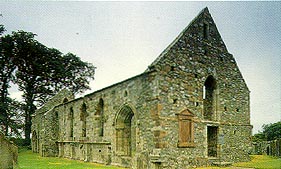| The Early Years |
| The Early Years |
The Emperor Theodosius died in 395, leaving the Roman Empire to two useless sons. The Picts had been through the Wall a generation before in the times of the British-born Maximus, Vicarius Britanniarum (Governor of the Britons), and he had driven them back. Now, in 396, they came again. And in that same year the Goths under Alaric marched through Macedonia and Thessaly, sacked Argos, Corinth, Sparta, and put Athens to ransom. They were held for a while but in 401 they rose again and marched on Italy. Not surprisingly troops were withdrawn from Britannia to help deal with them. As a result Alaric was pushed back, and the troops returned to Britannia again to cope with the Picts. However, in 405, they were needed again to oppose Radagaisus who rode at the head of 200,000 Vandals, Suevi, and Burgundians. In 406 Gaul also was invaded and, as a consequence, the following year the whole of Britannia was evacuated by the Roman garrison. We should remember that many of these Roman soldiers were in fact Britons.
The soldiers had gone: the orderly world they guarded had gone also: but behind them they left beside the Solway a Roman bishop, who did what the legions could not do in Caledonia and whose work was to endure longer than theirs - indeed, to this present day!
This was the son of a chief of a tribe called the Novantae, whose country was in what we call Galloway. His name was Nenn, or with the affectionate diminutive, Nennán, which in Latin gives Nennius or Ninnianus - the famous St Ninian of Candida Cassa. Now in Roman Britannia there was already a well-established Church. Since 324 Christianity had been the State religion all over the Empire. Tertullian early in the third century speaks of, Britannorum inaccessa Romanis loca, Christo vero subdita - places of the Britons, out of reach of the Romans, conquered by the true Christ. Ninian's father himself, apparently, was a Christian.
The saint was born about 362, in what was then independent territory. Before he was ten, Theodosius had recovered the district between the two Walls (Hadrian's and the Antonine), and it may have been as a hostage that the boy was sent to Rome for his education. {Another interpretation was that he was educated in the Roman way but not, necessarily, at Rome itself}. He received orders and eventually rose to the episcopate but, in time, he decided to return to his own people.
About 397 then Ninian returned to his own country and settled at Whithorn, which was then in a Roman province, and there build a community on the same lines as St Martin's. Its influence was felt outside Caledonia. Many great Irish saints were trained there - St Tighernac and St Kiarán, founder of the great school of Clonmacnoise; SS Finian and Kevin; St Finnbarr of Moville, the teacher of Colum Cille (St Columba) and supposed founder of Dornoch Cathedral; and Caranoc, who baptised the Briton St Patrick.

Later medieval buildings at Whithorn.
However, Ninian did not remain in Candida Cassa. He set out on journeys among the Pictish tribes. Bede's account mentions Ninian's work beyond "ardua et horrentia montium iuga" - the long ridge of watershed which is Druim Albann, known by the Romans as Dorsum Britanniae. Bede speaks of these tribes as the "southern Picts" but, when his famous map is re-oriented properly, south becomes east. In fact Ninian took the very natural route from Whithorn, by Cathures (Glasgow), Striling, and so by Strathmore and the Lowlands of the North-east, where modern archaeology has revealed his footprints quite clearly.
 |
- Kirkmadrine - Cathures {Glasgow} - Stirling {Eaglaise-Ninian} - Loch Leven {Gouderannet} - Strathmartin {Dichty Valley, near Dendee} - Abirlot - Dunottar {where the famous castle now stands} - Methlick - Glen Urquhart {an-Teampull, beside Loch Ness} - Navidale - Rinan's-ey {North Ronaldsay, Orkney}* - Ringan's Isle {Shetland}* * Not shown on map. |
In the early church, the communities (which would have had a church building of some kind associated with them) bore the name of their founders and these ancient names have, despite the attentions of the later Roman influences, survived in many places. Ancient church sites dedicated to St Ninian are found as far north as the Shetlands - some being so old that they were out of use by the sixth century!
By the time that Ninian died in 432, the Empire had lost Spain, Gaul and Britain, and Rome itself had been sacked. His community had become the home of many brave men who worked through the chaotic times, including, no doubt, some scholars fleeing from Gaul.
Ninian's work amongst the Picts was carried on, not only by his own pupils but by St Palladius, a Roman bishop, sent first, by tradition, to the Irish, who would not hear him, so that he came to Caledonia, and died at Fordun in Angus, leaving his charge to his pupils St Serf and St Ternan. Banchory-Ternan is St Ternan's bangor, or monastic school. St Serf, at Culross, was the master of St Kentigern, who continued St Ninian's work in the South-west, but under another rule than the King of the Picts.
"Thru his lif and his
techinge he Barbour |
![]()
e-mail: admin@cushnieent.force9.co.uk
© 2005 Cushnie Enterprises